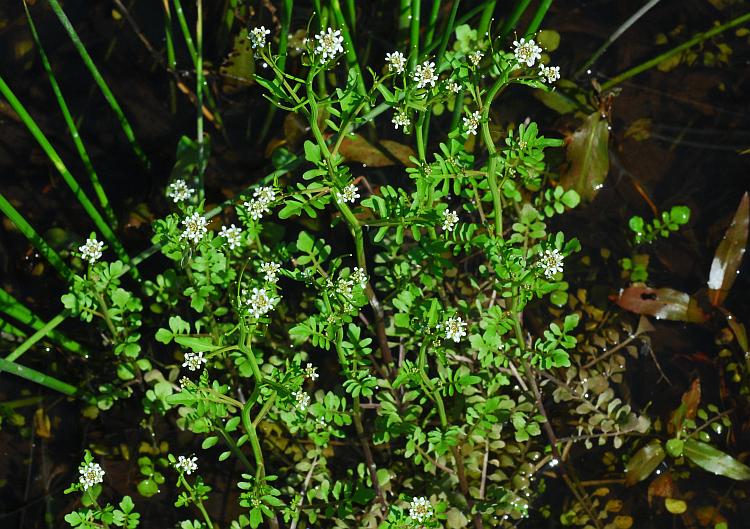Cardamine pensylvanica Muhl. ex Willd.
Bitter Cress

Native
CC = 6
CW = -3
MOC = 41
© SRTurner
Cardamine pensylvanica Muhl. ex Willd.Bitter Cress | |
 |
Native CC = 6 CW = -3 MOC = 41 |
© SRTurner |
|
Family - Brassicaceae Habit - Annual, biennial, or rarely short-lived perennial forbs, with fibrous and sometimes weak taproot. Stems - Ascending to erect, to 70 cm, multiple from the base, green, purple in strong sun, branching, mostly glabrous but often sparsely hairy near the base.
Leaves - Basal leaves sparse at flowering, not forming a rosette, 4-15 cm long, short-petiolate, pinnately compound with 5-13 leaflets, the lateral leaflets oblanceolate to obovate, entire or with 1-2 irregular teeth, tapered to a sessile base, this broadened at the very base and extending along the leaf rachis, the leaflets sometimes more or less connected by the flared leaflet bases, the terminal leaflet somewhat wider than the lateral leaflets, obovate to nearly circular. Stem leaves usually 5-8, mostly 4-8 cm long, pinnately compound with 5-13 leaflets, these oblanceolate or narrowly wedge-shaped to obovate, tapered to the base, this broadened at the very base and extending along the leaf rachis, the leaflets sometimes more or less connected by the flared leaflet bases, the terminal leaflet somewhat wider than the lateral leaflets but becoming narrower in upper leaves, oblanceolate to obovate or nearly circular. All leaflets glabrous, with 3 main veins from the base of the blade (visible abaxially). Lateral leaflets more numerous on upper leaves than lower.
Inflorescence - Terminal raceme, compact in flower, quickly elongating in fruit, to 10 cm long. Pedicels to 4 mm long in flower, to 6 mm long in fruit, ascending, glabrous. Axis of inflorescence glabrous.
Flowers - Sepals 4, 1.5-2.3 mm long, green, glabrous, cupped. Petals 4, 1.5-4.0 mm long, spreading, white, glabrous. Styles 0.5-1.0 mm long. Stamens 6, erect.
Fruits - Siliques 15-25 mm long, glabrous, terete, slightly beaked, ascending. Seeds 0.7-0.9 mm long, oval to oblong in outline, the margins sometimes slightly winged, the surface finely roughened, orangish tan. Flowering - March - July. Habitat - Mesic forests, spring branches, base of moist bluffs, crop field margins. Origin - Native to the U.S. Lookalikes - Cardamine parviflora, Cardamine hirsuta, Planodes virgincum. Other info. - This little species occurs throughout most of Missouri, but is most common in the southern half of the state. Elsewhere its range includes most of the continental U.S. and Canada, though it is uncommon in the western U.S. Plains states. It is morphologically variable and can be difficult to distinguish from C. parviflora in particular. Leaflets should be carefully examined for flaring and decurrent tissue at their bases, and their widths noted. Several leaves should be sampled for these characters. The two plants also grow in different habitats. C. pensylvanica grows in moist to wet soils of low areas and C. parviflora prefers drier soils of upland areas. Both plants can be eaten raw or cooked as greens. Photographs taken in Gainesville, FL., 2-16-03, and off Lee Rd 10, Lee County, AL., 3-2-06 (DETenaglia); also at Otter Slough Conservation Area, Stoddard County, MO, 4-15-2015, and Chloe Lowry Marsh Natural Area, Mercer County, MO, 4-19-2019 (SRTurner). |